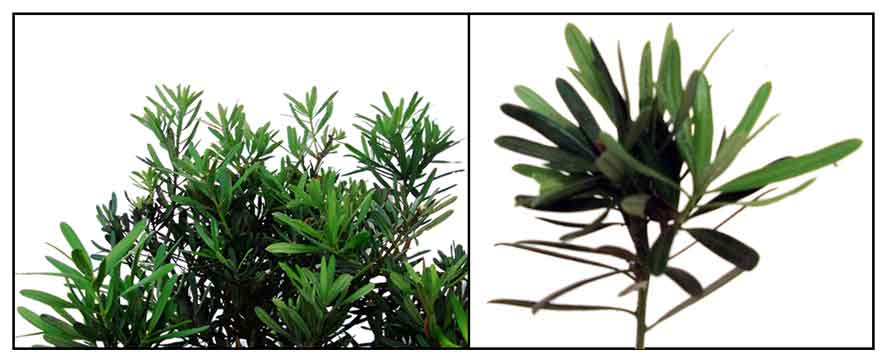|
 Botany Botany
Buddhist pine is an evergreen shrub or
tree that may grow 20 to 30 feet high. Branches are numerous, crowded
and upright. Leaves are narrow-linear to lanceolate, stiff with an acute
tip and obtuse base. Blade is dark green above and pale green below,
with entire margins. Male and female cones are in separate plants. Seed
is globose-ovoid and borne in a fleshy violet receptacle.
 Distribution Distribution
- Introduced to the
Philippines after WWII.
- Common garden cultivation.
Constituents
• Study yielded a new biflavonoid,
2,3-dihydro-4',4'''-di-O-methylamentoflavone and five known compounds viz., catechin, quercetin, 2,3-dihydrosciadopitysin, sciadopitysin, and isoginkgetin. (see study below) (1)
• From the leaves, study yielded hinokiflavone, neocryptomerin, sciadopitysin, podocarpusflavone A and podocarpusflavone B.
• Study of leaves and twigs isolated a new 8-aryl flavone, podocarflavone A, together with 15 previously reported flavonoids. (see study below) (8)
• Study of roots isolated two new norditerpenes (1), 2ß-hydroxymakilactone A and 3ß-hydroxymakilatone A (2), along with ten known analogues (3-12). (see study below) (10)
Properties
• Studies suggest anti-pigmentation, antimicrobial, cytotoxic, antiproliferative, cardioprotective properties.
Uses
Edibility
- Fruits reported to be edible, raw or cooked.
Folkloric
- No reported folkloric
medicinal use in the Philippines.
- Stem bark used in the treatment of worms, especially ringworm and blood disorders.
- Fruit decoction used as tonic for the heart, kidneys and stomach.
Others
- Wood: Used for making furniture, utensils, paper implements.
Studies
• Anti-Pigmentation / Biflavonoid:
Study yielded a new biflavonoid,
2,3-dihydro-4',4'''-di-O-methylamentoflavone and five known compounds viz., catechin, quercetin, 2,3-dihydrosciadopitysin, sciadopitysin, and isoginkgetin. The new biflavonoid was the most active component in inhibiting
pigmentation through inhibition of transcription of the genes encoding
TRP2. (1)
• Antimicrobial / Antifungal: A
study of South African Podocarpus species showed all four tested species
exhibited antimicrobial activity, the highest against K pneumonia. All
species exhibited strong antifungal activity. (2)
• Ponasterone / Mammary Gland Disease: Sustained mammary gland-directed, ponasterone A-inducible
expression in transgenic mice. The transgenic model with both tightly regulated and homogeneous transgene expression has broad practical applicability for genetic analysis of mammary gland disease. (3)
• Cytotoxic Dilactones: Study yielded 14 new bisnor- and norditerpene dilactones, makilactones E-R and 13 known bisnor- and norditerpenoids from the methanolic extract of the root and bark of Podocarpus macrophyllus. Many of the compounds showed potent cytotoxic activities against P388 murine leukemia cells. (4)
• Cardioprotective / Antioxidant / Flavonoids / Twigs and Leaves: Study of twigs and leaves isolated one 8-aryl flavone, podocarflavone A, together with 15 known flavonoids. The flavonoids exhibited significant cardioprotective effects by decreasing the H2O2-induced death of H9c2 cell and the levels of lactate dehydrogenase and creatine kinase, and by inhibiting the elevated intracellular concentration of reactive oxygen species. (8)
• Termiticidal / Wood: Extractives of wood were fractionated and tested for anti-termite activity. The activity was attributed to thee known bis-norditerpenoid inumakilactone and an unidentified and closely related compound. (9)
• Norditerpenes / Antiproliferative
/ Roots:Study of roots isolated two new norditerpenes (1), 2ß-hydroxymakilactone A and 3ß-hydroxymakilatone A (2), along with ten known analogues (3-12). Compounds were evaluated for cytotoxic activities against five human solid tumor cell lines (AGS, HeLa, MDA-MB-231, HepG-2, and PANC-1). All exhibited anti-proliferative activities with IC50s of 03-27 µM, except for compound 10. Compounds 1, 4, 5, 6, and 8 exhibited potent inhibitory activities against HeLa and AGS cells with IC50 < 1µM. (9)
Availability
Garden cultivation.
|


 Botany
Botany Distribution
Distribution 

